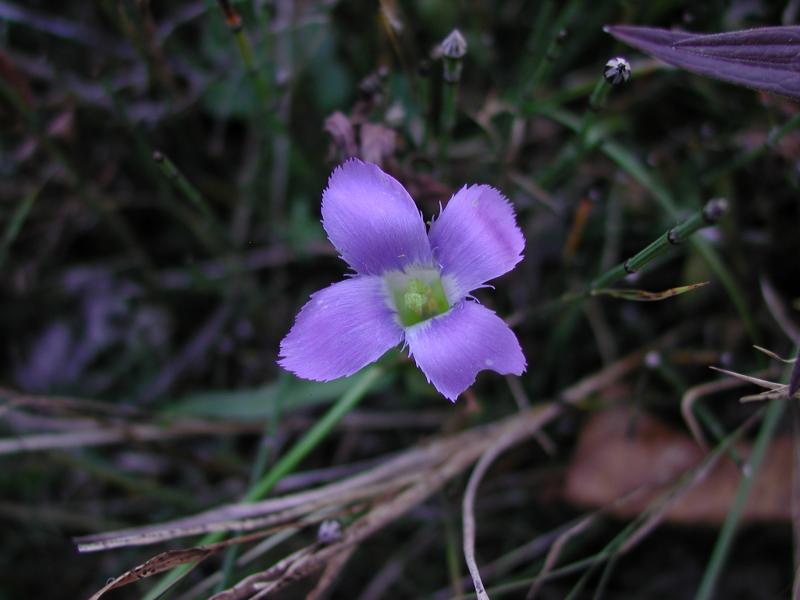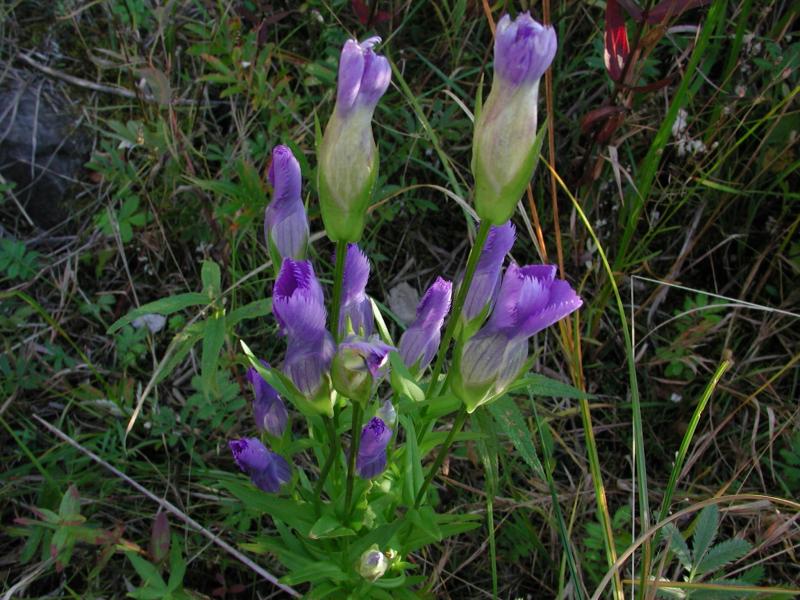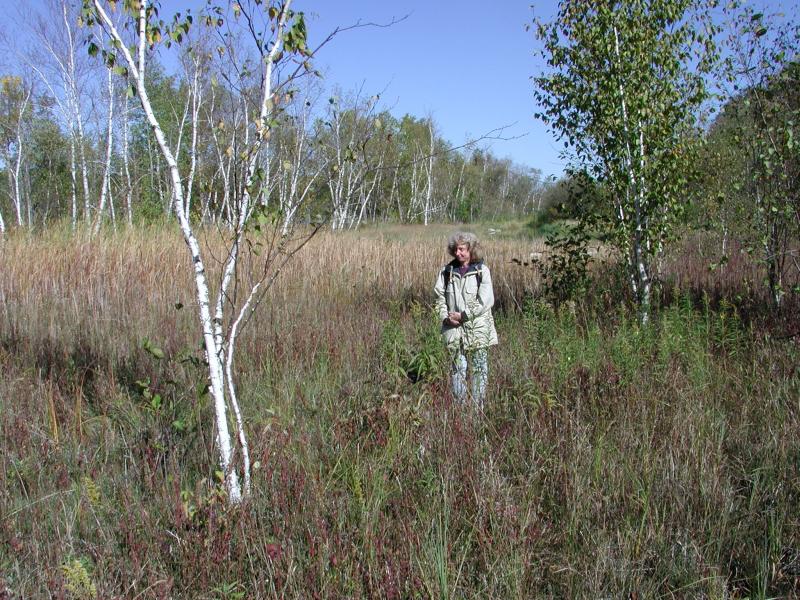Lesser Fringed Gentian
Gentianopsis virgata (Raf.) Holub
- Class
- Dicotyledoneae (Dicots)
- Family
- Gentianaceae (Gentian Family)
- State Protection
- Endangered
Listed as Endangered by New York State: in imminent danger of extirpation in New York. For animals, taking, importation, transportation, or possession is prohibited, except under license or permit. For plants, removal or damage without the consent of the landowner is prohibited.
- Federal Protection
- Not Listed
- State Conservation Status Rank
- S1
Critically Imperiled in New York - Especially vulnerable to disappearing from New York due to extreme rarity or other factors; typically 5 or fewer populations or locations in New York, very few individuals, very restricted range, very few remaining acres (or miles of stream), and/or very steep declines.
- Global Conservation Status Rank
- G5
Secure globally - Common in the world; widespread and abundant (but may be rare in some parts of its range).
Summary
Did you know?
This beautiful gentian was first discovered in New York in 1833 in the Niagara Falls area and is still only known from there and a second location along the St. Lawrence River.
State Ranking Justification
There are seven existing populations in two areas of the state. Only two populations have more than 100 plants and two are very small with fewer than ten plants. Threre are three other historical occurrences that are considered extirpated by development.
Short-term Trends
The existing populations seem stable although they occur in fragile environments.
Long-term Trends
Originally there were ten populations known but now there are seven.
Conservation and Management
Threats
Some cliff populations are threatened by rock removal, erosion of the cliff faces and trampling by adventure-seeking tourists. Riverside and cliff top populations are threatened by a succession of shrubs and trees, trampling by fishermen, and invasion by exotic species like purple loosestrife and Phragmites.
Conservation Strategies and Management Practices
Invasive species need to be suppressed around existing populations. Populations should be evaluated before any rock removal is attempted. Open areas should be kept free of tree and shrub succession.
Research Needs
Research is needed to see if populations can be augmented by propagation.
Habitat
Habitat
In New York Gentianopsis virgata is known from a variety generally moist, limey, rocky habitats. These include calcareous cliffs and ledges as well as seeps in limestone gorges, talus slopes, and rocky flats (New York Natural Heritage Program 2013). A calciphile of sandy, gravelly, rocky, and marly shores, wet meadows, crevices in limestone (or dolomite) pavements; interdunal hollows and calcareous flats along the Great Lakes (Voss 1996). Bogs, meadows, and wet shores, especially in calcareous regions (Gleason and Cronquist 1991). Boggy prairies, sandy swamps, borders of sloughs, wet calcareous rocks, etc. (Fernald 1950).
Associated Ecological Communities
- Alvar pavement grassland*
(guide)
This community consists of exposed, flat limestone or dolostone pavement with grassy or mossy patches interspersed throughout. Some examples may be solely grassland with no pavement.
- Alvar shrubland*
(guide)
A shrub-dominated community that has over 25% cover of tall, short, and dwarf shrubs. There are often deep crevices or grikes in the limestone pavement; trees and shrubs are often rooted in the grikes.
- Alvar woodland*
(guide)
A subset of the limestone woodland community restricted to the alvar region in Jefferson County, New York.
- Calcareous cliff community
(guide)
A community that occurs on vertical exposures of resistant, calcareous bedrock (such as limestone or dolomite) or consolidated material; these cliffs often include ledges and small areas of talus.
- Calcareous shoreline outcrop
(guide)
A community that occurs along the shores of lakes and streams on outcrops of calcareous rocks such as limestone and dolomite. The vegetation is sparse; most plants are rooted in rock crevices.
- Calcareous talus slope woodland*
(guide)
An open or closed canopy community that occurs on talus slopes composed of calcareous bedrock such as limestone or dolomite. The soils are usually moist and loamy; there may be numerous rock outcrops.
- Cobble shore
(guide)
A community that occurs on the well-drained cobble shores of lakes and streams. These shores are usually associated with high-energy waters (such as high-gradient streams), and they are likely to be scoured by floods or winter ice floes.
- Limestone woodland*
(guide)
A woodland that occurs on shallow soils over limestone bedrock in non-alvar settings, and usually includes numerous rock outcrops. There are usually several codominant trees, although one species may become dominant in any one stand.
- Rich sloping fen*
(guide)
A small, gently sloping wetland that occurs in a shallow depression on a slope composed of calcareous glacial deposits. Sloping fens are fed by small springs or groundwater seepage. Like other rich fens, their water sources have high concentrations of minerals and high pH values, generally from 6.0 to 7.8. They often have water flowing at the surface in small channels or rivulets.
* probable association but not confirmed.
Associated Species
- Acer negundo
- Achillea millefolium (yarrow)
- Agalinis paupercula var. borealis
- Agalinis tenuifolia (slender agalinis)
- Ageratina altissima var. altissima (common white snakeroot)
- Agrostis stolonifera (creeping bent)
- Carex viridula
- Equisetum variegatum
- Euthamia graminifolia (common flat-topped-goldenrod)
- Impatiens capensis (spotted jewelweed, spotted touch-me-not)
- Juncus effusus
- Lobelia kalmii (Kalm's lobelia)
- Lythrum salicaria (purple loosestrife)
- Packera paupercula (balsam groundsel)
- Parnassia glauca (common grass-of-Parnassus)
- Rhus typhina (stag-horn sumac)
- Rosa carolina
- Selaginella apoda (meadow spikemoss)
- Solanum dulcamara (bitter-sweet nightshade)
- Spiranthes cernua (nodding ladies'-tresses)
- Symphyotrichum lateriflorum (calico-aster)
- Symphyotrichum ontarione
- Thuja occidentalis (northern white cedar, arbor vitae)
- Toxicodendron radicans
- Vitis aestivalis (summer grape)
- Vitis riparia (river grape, frost grape)
- Zigadenus elegans ssp. glaucus
Range
New York State Distribution
Lesser fringed gentian occurs along the St. Lawrence and Niagara Rivers, and there is an additional historical record just south of Rochester.
Global Distribution
This plant ranges from New York and Quebec in the east, west through southern Ontario and Manitoba, and south from the Dakotas through the midwest to Pennsylvania.
Identification Comments
General Description
Gentianopsis virgata is an annual to biennial herbaceous plant with stems growing up to 50 cm tall, often branching near the top. The leaves are opposite in 8 to 13 pairs located below the primary flowering stalk (peduncle). The middle and upper stem leaves are linear or very narrowly lanceolate, 2 to 12 mm wide and 6 to 21 times as long with a sharply pointed tip. The flowers are strikingly rich blue to purple in color, and are 4-parted, funnel-shaped and 38 to 51 mm across and borne singly on slender stalks at the end of the main stem and in the upper leaf axils, with 1 to 6 flowers per plant. The petals are typically irregularly toothed (erose) across the top and fringed along their sides. The sepals are 1.5 to 4.5 cm long, tapering to a point (acuminate), and have keels completely covered with rough small, rounded projections (Fernald 1950).
Identifying Characteristics
Gentianopsis virgata is an annual to biennial herbaceous plant with stems growing up to 50 cm tall and often branching near the top. The leaves are opposite in 8 to 13 pairs located below the primary flowering stalk (peduncle). The middle and upper stem leaves are linear or very narrowly lanceolate, 2 to 12 mm wide and 6 to 21 times as long with a sharply pointed tip. The flowers are 4-parted, funnel-shaped and 38 to 51 mm across and borne singly on slender stalks (peduncle) at the end of the main stem and from the upper leaf axils with 1 to 6 flowers per plant. The calyx is 1.5 to 4.5 cm long, tapering to a point (acuminate) and with keels completely covered with rough small, rounded projections. The longer calyx lobes are linear-lanceolate and 1 to 3 cm long the shorter are broader with membranous margins. The flower petal (corolla) lobes are a strikingly rich blue to purple color, typically irregularly toothed (erose) across the top with fringe along their sides, and are spreading-ascending after they open. (Fernald 1950)
Best Life Stage for Proper Identification
For positive identification of lLsser Fringed Gentian, the entire plant including stem, leaves and mature flowers is needed.
Similar Species
Gentianopsis as a genus can be distinguished from other Gentians by its unfolded, fringed corollas.There are only two species of Gentianopsis in New York. Gentianopsis virgata is very similar in appearance to Gentianopsis crinita and it is often very difficult to distinguish the two species from one another. Voss (1996) reports that the "floral differences between G. virgata and G. crinita do not hold up, although there is a tendency for the cilia (fringe) at the end of the corolla lobes in G. procera to be reduced to little more than irregular teeth." Generally, G. crinita has wider leaves that are less than 4 times as long as broad or over 1 cm wide (usually both) and with a pronounced fringe across both the summit as well as the sides of the corolla lobes. More robust plants of G. virgata may have somewhat wider leaves than described in the literature, but these are also proportionally larger so that the length is 6-21 times the width, which is less than 1 cm at the widest point. (Michigan Flora Online 2011)
Best Time to See
Gentianopsis vrigata typically flowers beginning in mid-August and continuing into mid-October with mature fruits present from late September to mid-November.
- Flowering
- Fruiting
The time of year you would expect to find Lesser Fringed Gentian flowering and fruiting in New York.
Lesser Fringed Gentian Images
Taxonomy
Lesser Fringed Gentian
Gentianopsis virgata (Raf.) Holub
- Kingdom Plantae
- Phylum Anthophyta
- Class Dicotyledoneae
(Dicots)
- Order Gentianales
- Family Gentianaceae (Gentian Family)
- Order Gentianales
- Class Dicotyledoneae
(Dicots)
- Phylum Anthophyta
Additional Common Names
- Fringed Gentian
Synonyms
- Gentiana procera Holm
- Gentianopsis procera (Holm) Ma
Additional Resources
Best Identification Reference
Fernald, M.L. 1950. Gray's manual of botany. 8th edition. D. Van Nostrand, New York. 1632 pp.
Other References
Gleason, Henry A. and A. Cronquist. 1991. Manual of Vascular Plants of Northeastern United States and Adjacent Canada. The New York Botanical Garden, Bronx, New York. 910 pp.
Holmgren, Noel. 1998. The Illustrated Companion to Gleason and Cronquist's Manual. Illustrations of the Vascular Plants of Northeastern United States and Adjacent Canada. The New York Botanical Garden, Bronx, New York.
MICHIGAN FLORA ONLINE. A. A. Reznicek, E. G. Voss, & B. S. Walters. February 2011. University of Michigan. Web. Accessed March 8, 2013. http://www.michiganflora.net/
Mitchell, Richard S. and Gordon C. Tucker. 1997. Revised Checklist of New York State Plants. Contributions to a Flora of New York State. Checklist IV. Bulletin No. 490. New York State Museum. Albany, NY. 400 pp.
New York Natural Heritage Program. 2024. New York Natural Heritage Program Databases. Albany, NY.
Voss, E.G. 1996. Michigan Flora. Part III. Dicots (Pyrolaceae-Compositae). Cranbrook Institute of Science Bulletin 61 and Univ. Michigan Herbarium. Ann Arbor, Michigan. 622 pp.
Weldy, T. and D. Werier. 2010. New York flora atlas. [S.M. Landry, K.N. Campbell, and L.D. Mabe (original application development), Florida Center for Community Design and Research http://www.fccdr.usf.edu/. University of South Florida http://www.usf.edu/]. New York Flora Association http://newyork.plantatlas.usf.edu/, Albany, New York
Links
About This Guide
This guide was authored by: Stephen M. Young, Elizabeth Spencer, Richard M. Ring.
Information for this guide was last updated on: April 2, 2013
Please cite this page as:
New York Natural Heritage Program. 2024.
Online Conservation Guide for
Gentianopsis virgata.
Available from: https://guides.nynhp.org/lesser-fringed-gentian/.
Accessed July 26, 2024.


